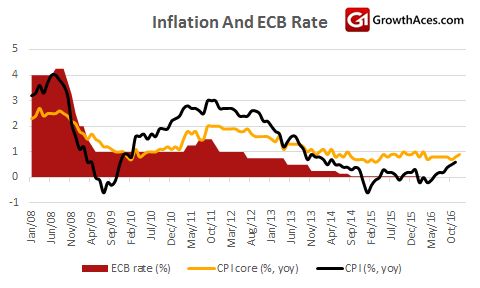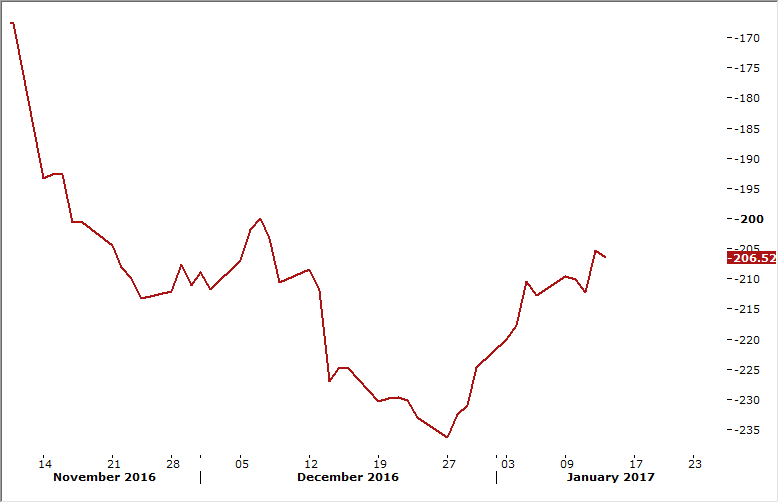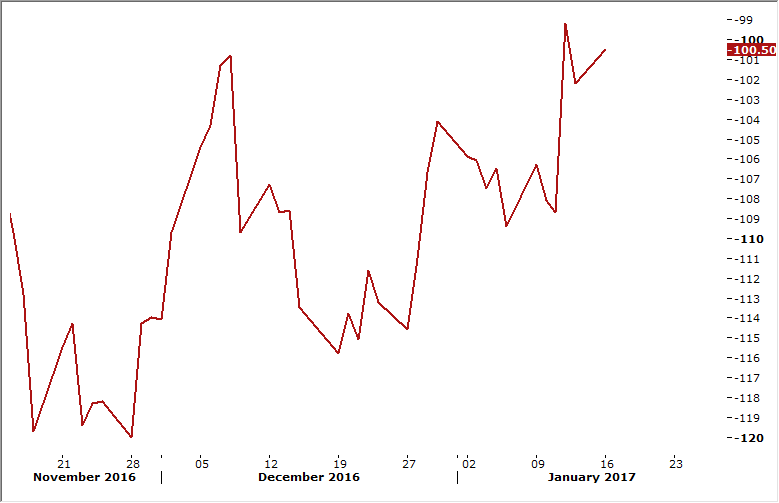Macroeconomic overview
-
We do not expect new policy announcements when the ECB meets this week (Thursday). Therefore, the monetary policy framework will remain the same as announced on 8 December: EUR 80 billion of monthly asset purchases until March, with a slowdown to EUR 60bn per month in the remaining nine months of the year.
-
We think that ECB President Draghi will sound constructive, but dovish. In this regard, separating short from medium-term developments may be an important part of his communication strategy. He will probably acknowledge that risks in the short term are moving towards faster-than-expected headline inflation and a more balanced growth assessment. Importantly, however, we also expect Draghi to emphasize that uncertainty remains elevated and the medium-term outlook – most relevant for monetary policy – has not changed much from last month. Therefore, the ECB still wants financial conditions to remain very loose.
-
Since the December meeting, incoming data have pointed to a strengthening of the economic recovery and a sharp acceleration in headline inflation driven by energy prices, while underlying price pressure has remained weak. The good news is that most survey indicators suggest GDP growth accelerating to a pace of about 2% annualized at the turn of the year: if confirmed by hard data – and this is happening for now - this would imply some upside risks to the ECB’s growth projections. On a similar note, the inflation jump between the end of 2016 and the beginning of 2017 is likely to exceed ECB expectations, as euro-denominated oil prices are currently about 15% higher than the central bank’s technical assumption for the 2017 average.
-
The ECB may acknowledge recent progress on the price front, but is unlikely to be impressed by survey-base evidence, especially after having systematically revised down its core CPI and wage growth projections over the last several quarters. Benoit Coeure, usually very aligned to Draghi’s thinking, linked the 8 December announcements to shifting inflation risks, largely on the account of higher oil prices. However, he rebuffed the view that the ECB is moving towards the exit, because “we are still waiting for signs that core inflation is on the rise and will clearly exceed 1%”. Last week, Yves Mersch, a hawkish member of the Governing Council, claimed, “It is absolutely premature today to claim victory over a weak economy”.
-
The EUR/USD has started 2017 on a strong footing. Its upward move can be ascribed to three factors. First of all, investors have reassessed their “euphoria” that followed Donald Trump’s election and the consequent USD rally. Second, the December FOMC minutes showed some board members concerned about the impact of the strong USD on exports. And third, inflation and early activity indicators are picking up across Europe. Although the consumer price increase has been mostly oil-driven, this broad-based improvement is affecting, in a positive way, investors’ perception of the outlook and the debate has already resumed about how much accommodative monetary policy is needed across the Eurozone. Although this-week ECB meeting of 2017 is unlikely to impact the currency, the forward-looking nature of markets should keep the EUR/USD supported.
Technical analysis
- The EUR/USD is weaker today in a calm trade, but remains above 14-day exponential moving average. Technical analysis supports bullish view in the short term. RSIs are biased up again and a long lower wick is in place on the monthly candle. Long upper wicks on recent daily candles are concerns though. A break above 1.0700 will have us in solid shape to reach the target.
- Yield spread between 10-year German and US bonds
EUR/GBP: Will May signal a hard Brexit on Tuesday?
Macroeconomic overview
-
The GBP Sterling skidded to its lowest levels in 32 years on Monday, hit by fears that Prime Minister Theresa May will say on Tuesday that Britain is set for a "hard" Brexit out of the EU and its single market. Investors have been worried such a decisive break from the single market would hurt British exports and drive foreign investment out of the country.
-
The speech has been much anticipated since May’s testimony to the Liaison Committee on 20 December when she promised to set out more details of her Brexit strategy in the new year.
-
With less than 80 days to go before Theresa May’s self-imposed deadline for triggering Article 50 by the end of March, the Prime Minister is under pressure to provide more details on the government’s negotiating strategy. If the UK is to avoid both a “hard Brexit” and an abrupt exit, May will have to move to a more conciliatory tone and soon, but so far this has not been the case.
-
There will be some important UK macroeconomic releases this week, but political developments should remain in the driver’s seat. We expect headline inflation (on Tuesday) to rise to 1.3% yoy in December, while core inflation will probably hold at 1.4% yoy.
- Jobs report will be released on Wednesday. We expect the unemployment rate to edge up to 4.9% in the three months to November. Wage growth likely remained resilient in November, but real wage growth is set to slow as inflation rises.
Technical analysis
- A report on Sunday that Theresa May is likely to signal a “hard” Brexit approach in her speech saw sterling gapping lower in Asian trading hours. We think the gap is likely to be closed in the coming hours and this could be an opportunity to open a long position. The EUR/GBP bias remains for upside and a solid support level is 38.2% fibo of October-December fall at 0.8708.
- Yield spread between 10-year German and British bonds
Our research is based on information obtained from or are based upon public information sources. We consider them to be reliable but we assume no liability of their completeness and accuracy. All analyses and opinions found in our reports are the independent judgment of their authors at the time of writing. The opinions are for information purposes only and are neither an offer nor a recommendation to purchase or sell securities. By reading our research you fully agree we are not liable for any decisions you make regarding any information provided in our reports. Investing, trading and speculation in any financial markets may involve high risk of loss. We strongly advise you to contact a certified investment advisor and we encourage you to do your own research before making any investment decision.
Recommended Content
Editors’ Picks

USD/JPY pops and drops on BoJ's expected hold
USD/JPY reverses a knee-jerk spike to 142.80 and returns to the red below 142.50 after the Bank of Japan announced on Friday that it maintained the short-term rate target in the range of 0.15%-0.25%, as widely expected. Governor Ueda's press conference is next in focus.

AUD/USD bears attack 0.6800 amid PBOC's status-quo, cautious mood
AUD/USD attacks 0.6800 in Friday's Asian trading, extending its gradual retreat after the PBOC unexpectedly left mortgage lending rates unchanged in September. A cautious market mood also adds to the weight on the Aussie. Fedspeak eyed.

Gold consolidates near record high, bullish potential seems intact
Gold price regained positive traction on Thursday and rallied back closer to the all-time peak touched the previous day in reaction to the Federal Reserve's decision to start the policy easing cycle with an oversized rate cut.

Ethereum rallies over 6% following decision to split Pectra upgrade into two phases
In its Consensus Layer Call on Thursday, Ethereum developers decided to split the upcoming Pectra upgrade into two batches. The decision follows concerns about potential risks in shipping the previously approved series of Ethereum improvement proposals.

Bank of Japan set to keep rates on hold after July’s hike shocked markets
The Bank of Japan is expected to keep its short-term interest rate target between 0.15% and 0.25% on Friday, following the conclusion of its two-day monetary policy review. The decision is set to be announced during the early Asian session.

Moneta Markets review 2024: All you need to know
VERIFIED In this review, the FXStreet team provides an independent and thorough analysis based on direct testing and real experiences with Moneta Markets – an excellent broker for novice to intermediate forex traders who want to broaden their knowledge base.





